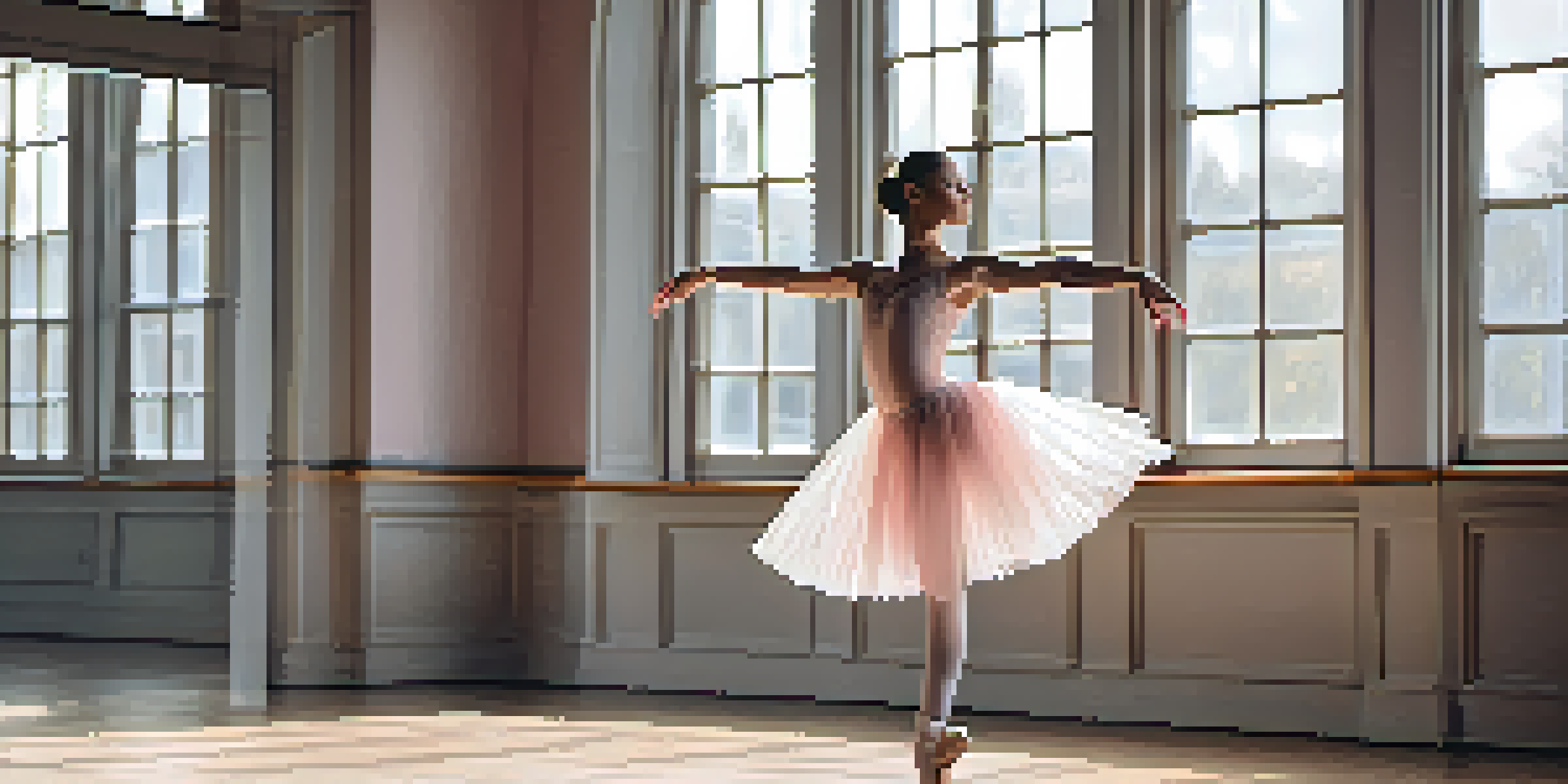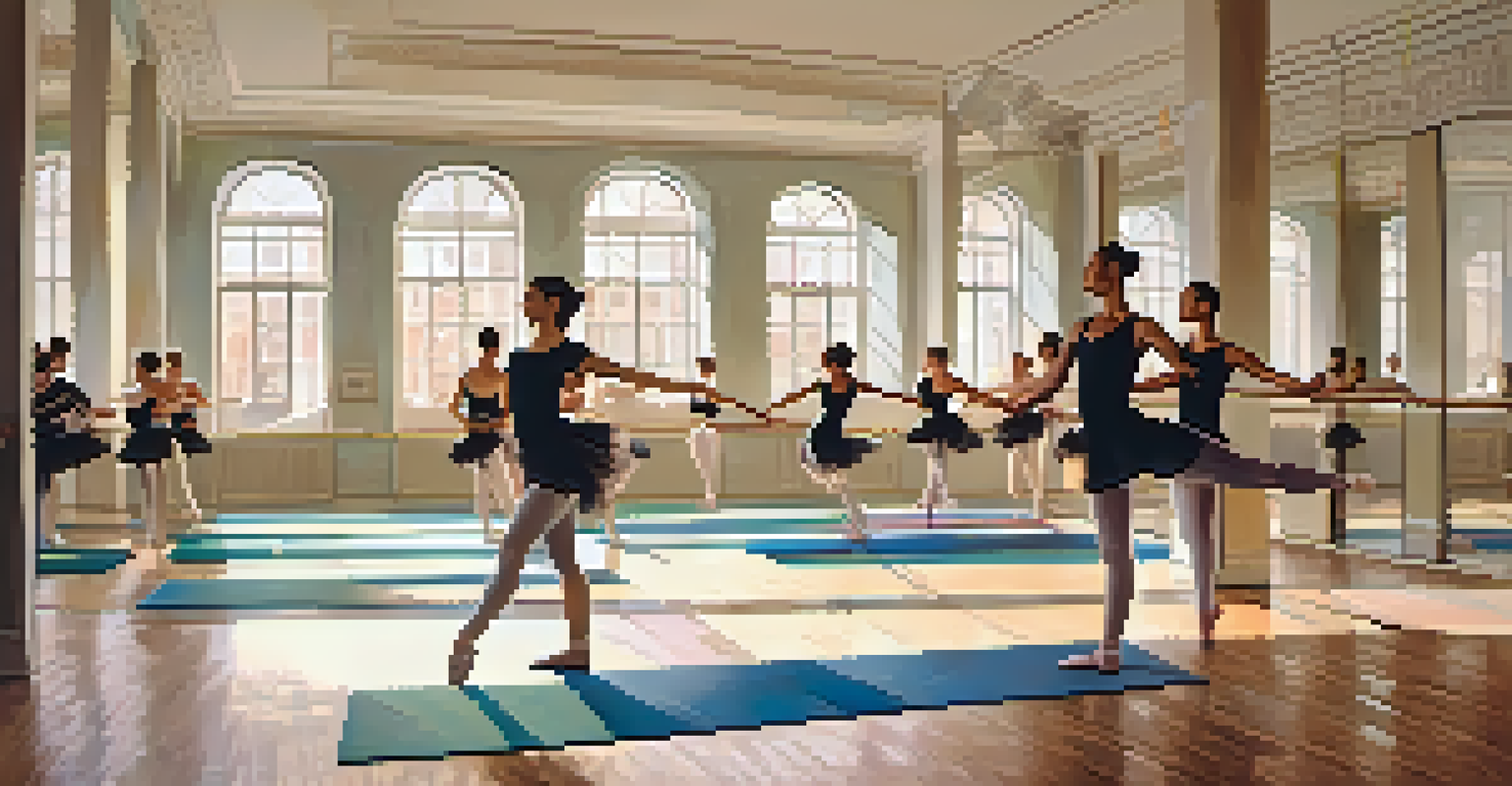Exploring the Science Behind Ballet Technique Training

Understanding the Basics of Ballet Technique
Ballet technique is the foundation of every dancer's training, emphasizing posture, alignment, and movement. It combines physical strength with grace, requiring dancers to develop a deep understanding of their bodies. This base allows for the execution of complex movements that are critical to ballet performances.
Ballet is like dreaming with your feet.
At its core, ballet technique involves specific positions of the feet and arms, each serving a purpose in creating visually stunning choreography. For instance, the 'plié' not only prepares the dancer for jumps but also helps to enhance flexibility and strength. Mastering these basics is crucial, as they lead to more advanced techniques down the line.
Moreover, a solid grasp of ballet fundamentals fosters a dancer's confidence and stage presence. When dancers understand the 'why' behind each movement, they can express themselves more authentically, captivating their audience with both skill and emotion.
The Role of Anatomy in Ballet Training
Anatomy plays a significant role in ballet training, as understanding the body's mechanics allows dancers to move more efficiently. Knowledge of muscle groups, joint alignment, and body composition helps dancers avoid injuries while improving their technique. For example, understanding how the hip joint works can aid in executing a perfect 'arabesque.'

Additionally, a dancer's physical structure, such as leg length and flexibility, can influence their training approach. By focusing on individual anatomy, teachers can tailor exercises to enhance each dancer's strengths and address their weaknesses. This personalized approach fosters a more effective learning environment.
Ballet Technique Fundamentals
Mastering basic ballet positions and movements is essential for executing complex choreography and enhancing a dancer's performance.
Furthermore, awareness of body mechanics encourages dancers to cultivate proper habits early on. This not only enhances performance but also instills a lifelong appreciation for their bodies, promoting healthier training practices and reducing the risk of chronic injuries.
The Importance of Muscle Strength and Conditioning
Muscle strength and conditioning are crucial for ballet dancers, as they provide the physical power needed to execute demanding movements. Strength training focuses on developing the core, legs, and arms, which are vital for balance, control, and flexibility. For instance, a strong core enables a dancer to maintain stability during turns and jumps.
The body is your instrument, you must learn to control it.
Incorporating resistance training, such as using bands or weights, can significantly enhance a dancer's performance. This type of conditioning not only builds muscle but also improves overall endurance, allowing dancers to maintain energy throughout long rehearsals and performances. Think of it as building a solid foundation for a beautiful house.
Moreover, strength training can prevent injuries by reinforcing muscles and joints. By ensuring that the body is well-conditioned, dancers can perform at their best while minimizing the risk of strains or sprains that could sideline their training.
Flexibility: A Key Component of Ballet Technique
Flexibility is often seen as a hallmark of ballet, enabling dancers to achieve stunning lines and extensions. However, it’s not just about bending; it’s about controlled movement and achieving the right range of motion. Stretching exercises, both dynamic and static, enhance flexibility while ensuring that the muscles remain strong and resilient.
Incorporating daily stretching routines can significantly improve a dancer's performance. For example, front splits and backbends increase the range of motion in the hips and spine, allowing for more expressive movements. This emphasis on flexibility also plays a role in injury prevention, as well-stretched muscles are less likely to tear during intense training.
Anatomy and Injury Prevention
Understanding body mechanics and individual anatomy allows dancers to train efficiently while minimizing the risk of injuries.
Moreover, understanding the science of flexibility helps dancers know their limits. Pushing too hard can lead to injuries, so it’s essential to find a balance between flexibility and strength. Finding this equilibrium is key to achieving the graceful movements that define ballet.
Mind-Body Connection in Ballet Training
The mind-body connection is a pivotal aspect of ballet training, influencing how dancers perform movements and express emotions. By being present in the moment, dancers can enhance their technique and artistry. This connection is often cultivated through mindfulness practices, such as visualization and focused breathing.
For instance, visualizing a perfect pirouette can help dancers execute the movement more fluidly. This mental practice allows them to anticipate their body's actions and make necessary adjustments in real-time, bridging the gap between thought and movement. Such techniques can lead to improved confidence and performance.
Moreover, fostering this connection can aid in overcoming performance anxiety. By grounding themselves in the present moment, dancers can channel their nervous energy into their performance, transforming potential anxiety into a powerful expression of art.
Injury Prevention Strategies for Ballet Dancers
Injury prevention is paramount in ballet training, as the physical demands can lead to various strains and sprains. Understanding the common injuries, such as tendonitis or stress fractures, helps dancers take proactive measures. Regular check-ins with healthcare professionals can ensure that dancers remain healthy and injury-free.
Incorporating proper warm-up and cool-down routines is essential for maintaining physical health. A thorough warm-up prepares the muscles for intense activity, while cool-downs help in recovery, reducing soreness and stiffness. Think of it as preparing a car for a long drive; you wouldn’t skip the oil check!
Future of Ballet Training
Integrating technology and interdisciplinary approaches into ballet training fosters innovation and enhances dancers' skill sets.
Additionally, listening to one's body is crucial. Dancers should be aware of any discomfort and take necessary breaks to prevent further injury. By prioritizing their well-being, dancers can enjoy a long and fruitful career in ballet without the setbacks of injuries.
The Future of Ballet Technique Training
As ballet continues to evolve, so does the approach to technique training. Integrating technology, such as motion capture and video analysis, allows dancers to receive real-time feedback on their movements. This data-driven approach can enhance training and provide insights that traditional methods may overlook.
Moreover, the rise of interdisciplinary training—combining ballet with other forms of dance or fitness—enriches a dancer's skill set. This blending of styles encourages innovation and creativity, paving the way for new forms of expression within ballet. It’s like adding new colors to a painter’s palette!

Ultimately, the future of ballet technique training lies in a holistic approach that values both physical and mental well-being. By embracing new techniques and technology, dancers can continue to push the boundaries of their art, ensuring that ballet remains a dynamic and captivating form of expression.